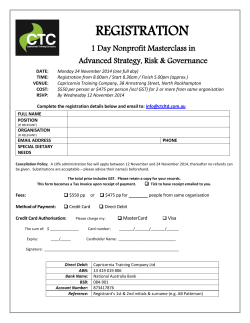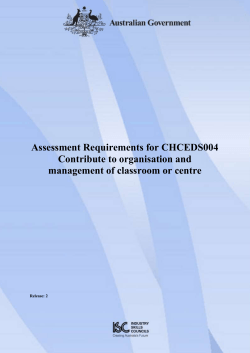
Lecture 1 â Introduction Employment skills
Lecture 1 – Introduction Employment skills - Interpersonal and communication skills - Drive, commitment and attitude - Critical reasoning skills - Academic results - Work experience - Cultural alignment/ values fit Teamwork skills Emotional intelligence Leadership skills Extra-curricular activities Key Management Skills - Human Skills - Technical Skills - Conceptual Skills Business Environments Every business operates in an overlapping mix of dynamic environments that continuously create both opportunities and constraints. Management Practices Dimensions PERFORMANCE MONITORING: - Introduction of modern techniques - Rationale for modern techniques - Process problem documentation - Performance tracking - Performance review - Performance dialogue TARGET SETTING - Target balance - Target interconnection - Target time horizon - Target stretching - Performance clarity PEOPLE MANAGEMENT - Managing human capital - Rewarding high performance - Removing poor performers - Promoting high performers - Attracting human capital - Retaining human capital - Consequence management What is management? MANAGEMENT is the process of effectively and efficiently planning, organising, leading and controlling people to achieve the organisation’s goals and objectives whilst balancing the demands and pressures of the external environment. Working in teams Passion for change (in the future) Creativity Trust Ethical Lecture 2 – Business Information Systems A Systems view of Business SYSTEM: a set of interacting components that form an integrated whole ! e.g. an organisation or business. In order to create a functioning unit, and to design, create and manage a business, an understanding of the purpose of the business, how to organise all the parts of the business etc. must be obtained: ! Interacts with its environment – input, output, purpose (an entity) ! Resources, data, people ! System has a boundary: defines the scope of the system ! Systems can form a hierarchy: system as part of a larger system ! System has structure: parts that are related to each other ! System has behavior: it contains processes i.e. the way it’s run (the parts interact) ! Input ! Throughput ! Output ! Unlimited liability PARTNERSHIPS: ! Relationship which exists between 2 or more ! Difficulties in raising and retaining capital persons carrying on business with a view to a ! Issues with longevity profit ! Unlimited liability ! No separate legal entity ! Partners exposed to a joint and several liability BUSINESS – SMALL ! Major contribution towards GDP ! Provide more than 50% of employment ! Almost 2 million in Australia ! Introduce new products ! Over 96% of all businesses in Australia ! Innovate and take risks LIMITATIONS (HISTORICALLY): ! Small in scale ! Limited in their capacity to raise and retain capital ! Sporadic/ Episodic/ Transactionally Dominated ! Limited in their capacity to diversify/ manage risk ! Indifferentiable from the human actors who drove them and thus impermanent However: ! Substantial numbers of businesses are so large, complex and broad in scope that they comprehensively defy the types and characteristics enumerated ! Some of the businesses are so large and wield such influence that they have been argued to raise challenges to the more traditional dominant institutions e.g. the state The key issue with small businesses is unlimited liability – limiting how much risk we can take on etc. By creating a corporation (separate legal personality) ! it will continue if a shareholder dies, a lot more potential resources at its disposal, access to capital etc. and the losses are the company’s, not the individual shareholder’s Risk partitioning – i.e. subsidiaries so if one part goes out of business, the rest of the business won’t be exposed PRIVATE COMPANY: ! Limited liability for shareholders ! Shares not traded on an exchange ! Often family-owned INITIAL PUBLIC OFFERING (IPO): ! Selling shares in a company to the public ! Usually via an exchange like ASX ! Expands the investor base ! Creates greater compliance and reporting burden ! Shareholders elect the board of directors who hire the corporate officers who hire employees Mergers and Acquisitions ! MERGER: when two companies become a single entity ! ACQUISITION: one company buying another company o Primarily motivated by synergy: the increase in performance of the combined firm over what the two firms are already expected to accomplish as independent firms Alliances and Joint Ventures ! ALLIANCE: long-term partnership between firms to develop, produce or sell products (allows access to a larger market and new technologies) ! JOINT VENTURE: separate legal entity between multiple firms Lecture 4 – Business Strategy Strategic planning process 1. Define mission, vision and values 2. Perform SWOT analysis 3. Develop forecasts 4. Analyse the competition 5. Establish goals and objectives 6. Develop action plans To achieve a strategic outcome – every business needs to have a vision and a mission. Vision – where we want to be (aspirational) ! Clear and powerful statement about the direction in which the organisation needs to move Mission statement – how we get there and why we chose this route ! How the organisation relates to its public and communities ! What services it provides ! Who benefits as a result of its work ! How it improves the quality of life Sustainable competitive advantage (outperforming competitors for the long-run) ! To do this, a strategy is needed – a game plan; how to get from A to B o Outperform opponents – predict their next move o Speed o Perform under pressure o Straightforward o Think about where opponents are at all times o Dynamic – backed up by data and analysis Why is strategy important? ! Provides a long-term focus ! Helps set goals and objectives ! Allows to control and monitor performance ! Helps allocate resources in an optimal way ! ! ! ! Helps prepare for future disruptions Integrates different parts of organisation Can be an internal change driver Helps develop the workforce RATIONAL APPROACH – Analysis ! formation ! implementation INCREMENTAL APPROACH – not that straightforward, adapt plan Tools for analysis Internal – Core competence: those activities of an organisation that give it an advantage over its competitors e.g. Qantas’ customer service External – Porter’s 5 forces: - competitive rivalry ! Power of suppliers ! Threats of new entrants ! Power of customers ! Threats of substitutes External and internal – SWOT ! STRENGTHS: positive internal factors within your control on which you could capitalize ! WEAKENESSES: negative internal factors within your control that should be limited or improved upon ! OPPORTUNITIES: positive external factors outside of your control on which you could capitalise ! THREATS: negative external factors outside of your control whose effects you should seek to lessen Example Qantas STRENGTHS – pilots, fleet, history, reputation, frequent flier WEAKNESS – safety concerns, maintenance, strike concerns, scheduling OPPORTUNITIES – growth in Asia, FIFO growth locally, new technology THREATS – oil, Singapore airlines, parliament – carbon regulation etc Internal environment: strengths and weaknesses ! Structure that helps achieve objectives ! Clear strategy and marketing objectives ! Effective use of IT in all aspects of activities ! Investment in R&D match/exceed competitors External environment: opportunities and threats ! Political-legal, economic, socio-cultural and technological factors ! Market strength of competitors ! ! Meet financial objectives Clear human resource management objectives/strategies in employee motivation, turnover of staff and provision of training ! New products/services of the firm and competitors out there Level of consumer demand, stability of this Threat of new entrants in the market ! ! Differentiation strategy ! Make your product as unique as possible ! Quality and distinctiveness are key features of the Customer Value Proposition ! Focus on responding to customer needs Cost-leadership strategy ! Make your product as cheap as possible ! Price is the key feature of the Customer Value Proposition ! Focus on internal efficiencies to lower production costs Focus strategies ! Focusing on a particular market segment or geographical area ! Customer Value Proposition focuses on the needs of the customer segment – price or quality ! Focus strategy can use differentiation or cost leadership Means-end: ! Identify strategic goal ! Examine each option in which this goal can be achieved ! Evaluate strengths and weaknesses of each option ! Implement the best option Implementing strategy: leading and organising ! Crafting the vision and strategy ! Ensuring strategy becomes a reality ! Managing people ! Allocating resources, selecting structures and making decisions Implementation often fails due to: ! Lack of clear communication from the top to the frontline ! Lack of clear planning ! Lack of monitoring and control ! Lack of accountability and reward Lecture 5: Management, Organisation and Teamwork MANAGEMENT ! The process of planning, organising, leading and controlling to meet organisational goals Managerial roles: ! Behavioural patterns and activities involved in carrying out the functions of management; including interpersonal (people), informational and decision-making roles 1. The Planning Function: ! Planning: establishing objectives and goals for an organisation and determining the best ways to accomplish them ! Strategic plans: plans that establish the actions and the resource allocation required to accomplish strategic goals o Usually defined for periods of 2-5 years and developed by top managers 1. Mission statement: a brief statement of why an organisation exists; what the organisation aims to accomplish for customers, investors, and other stakeholders e.g. to provide consumers with a drink that makes them happy Vision statement: a brief and inspirational expression of what a company aspires to be e.g. to be a leader in the provision of Chinese herbs Values statement: a brief articulation of the principles that guide a company’s decisions and behaviours e.g. a quality product and efficient service 2. SWOT: HP – developing the business i.e. perform a SWOT or Porter’s 5 Forces Analysis 3. Developing forecasts Quantitative forecasts: typically based on historical data or tests and often involve complex statistical computations Qualitative forecasts: based on intuitive judgements 4. Analyse the competition Intuitive
© Copyright 2025











